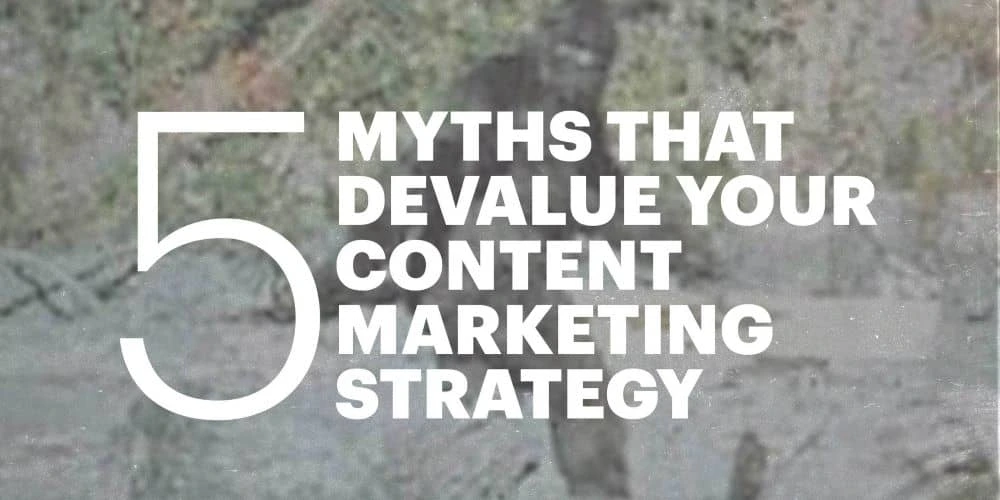A good content marketing strategy should explain why a company is making the marketing decisions that it is. Anyone reading should see why content marketing is being used, why certain decisions are being made, and why the company wants the image it’s pursuing.
Unfortunately, since content marketing varies as widely as the brands using it, myths and legends about how to make it work still abound. With 70% of B2B brands planning to use content marketing next year, these myths will continue to spread into a new generation of marketing campaigns. That is, unless we marketers agree to let these myths go the way of Bigfoot and Nessie.
New to content marketing? Start off on the right foot with Lucidpress.
Myth #1: Trending topics will always work out
Let’s go viral! There’s this idea that the best way to market a brand is by latching onto an outrageous topic which will immediately grab the attention of anyone around. (Oh look, a shiny thing!) While interesting topics are undoubtedly fun, they’re not always a surefire win. Marketing topics should always coincide with the company’s message and values. Remember that trending topics rarely remain so, and one can quickly change from being adored to being annoying. Sigh—crowds can be so fickle. But setting smart goals for your content, whether it’s brand awareness or targeted selling, will help you keep the company’s mission as your North Star.
An example of doing this the right way? Our sister brand Lucidchart created this hilarious video about dogs (erm, that is, “doggos”) that is not only timely Internet humor—it also shows off what you can do with the product. In this case, the topic and the brand fit neatly into the middle of the viral Venn diagram, and the video has been a huge success.
Myth #2: Keywords are the most important factor
One particularly pervasive myth is that marketers should trust keyword data above all—even over the intentions of potential customers as shown by their search queries. In order for keywords to work at their best, they must be focused on the customer’s journey. SEO tools will only get you halfway there. []
Use keyword data to inform your content marketing strategy, not determine it outright. Think about why someone would search for a particular keyword—and what questions they have that aren’t being answered by existing search results. Match individual keywords to the different personas your brand targets so you can speak to the audience who most wants to hear what you have to say. All of this should lead to more interesting, relevant content that’s more valuable than simply writing about a keyword.
Note: Another myth surrounding keywords is that using them removes any creativity from writing altogether. Not only is this pretty lazy thinking—it actively undermines content writing as a means of marketing the business. SEO and content marketing should work together to support one another, and neither should become too dominant in your strategy. This leads us to our next myth…
Myth #3: All storytelling, no selling
Content marketing is a form of marketing (shocking, I know) which uses storytelling to draw in prospects and excite them about your brand, product or service. Around half of marketers admit to focusing more on the creative work than on measuring the results—which means they’re missing an opportunity to bring themselves into closer alignment with the needs currently driving their customers. You can tell great stories all day long, but if your audience isn’t being moved down the funnel, it does very little for your brand’s bottom line.
To an extent, content marketing can be considered a form of brand building. People often remember the content of a marketing campaign more easily and affectionately than they do the products and services on offer. This has contributed to the belief that storytelling is more important than selling, when in reality they should be equal. The content marketing should enhance your brand’s offerings—not the other way around. And speaking of brand building…
Myth #4: Content marketing is separate from brand building
We touched on this briefly in the previous section, but there is a pervading myth that brand building and content marketing are separate disciplines. In today’s world, they intersect. Brand building is accomplished through marketing; the specific nature of content marketing makes it even more useful to growing brands.
Brand building and content marketing are best mixed together because they build trust and good rapport between a brand and its followers, while simultaneously helping the brand become more visible and easily recognized. Combining the two results in consistently well-branded content that contributes to a brand’s image, reputation and conversion funnel.
Myth #5: Your content should only be hosted on your website
Content marketing can cover a variety of mediums and senses. However, many brands miss out on exciting possibilities and partnerships by keeping all of their work on their own sites. Podcasting, vlogging and guest blogging open doors to entirely new audiences who might not have interacted with your brand otherwise. You can even look for new channels to help distribute your content. For example, we’ve had success with a Lucidpress publication on Medium because it plugs us into active reading communities who are interested in our niche.
Key takeaway
Content marketing has become a popular branding strategy, but it’s still shrouded in a variety of myths which make it less successful than it should be. Toss these myths by the wayside and use these tips to connect with loyal brand followers and new audiences.



